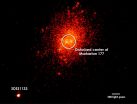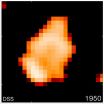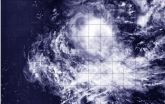(Press-News.org) An international team of researchers analyzing decades of observations from many facilities, including NASA's Swift satellite, has discovered an unusual source of light in a galaxy some 90 million light-years away.
The object's curious properties make it a good match for a supermassive black hole ejected from its home galaxy after merging with another giant black hole. But astronomers can't yet rule out an alternative possibility. The source, called SDSS1133, may be the remnant of a massive star that erupted for a record period of time before destroying itself in a supernova explosion.
"With the data we have in hand, we can't yet distinguish between these two scenarios," said lead researcher Michael Koss, an astronomer at ETH Zurich, the Swiss Federal Institute of Technology. "One exciting discovery made with NASA's Swift is that the brightness of SDSS1133 has changed little in optical or ultraviolet light for a decade, which is not something typically seen in a young supernova remnant."
In a study published in the Nov. 21 edition of Monthly Notices of the Royal Astronomical Society, Koss and his colleagues report that the source has brightened significantly in visible light during the past six months, a trend that, if maintained, would bolster the black hole interpretation. To analyze the object in greater detail, the team is planning ultraviolet observations with the Cosmic Origins Spectrograph aboard the Hubble Space Telescope in October 2015.
Whatever SDSS1133 is, it's persistent. The team was able to detect it in astronomical surveys dating back more than 60 years.
The mystery object is part of the dwarf galaxy Markarian 177, located in the bowl of the Big Dipper, a well-known star pattern within the constellation Ursa Major. Although supermassive black holes usually occupy galactic centers, SDSS1133 is located at least 2,600 light-years from its host galaxy's core.
In June 2013, the researchers obtained high-resolution near-infrared images of the object using the 10-meter Keck II telescope at the W. M. Keck Observatory in Hawaii. They reveal the emitting region of SDSS1133 is less than 40 light-years across and that the center of Markarian 177 shows evidence of intense star formation and other features indicating a recent disturbance.
"We suspect we're seeing the aftermath of a merger of two small galaxies and their central black holes," said co-author Laura Blecha, an Einstein Fellow in the University of Maryland's Department of Astronomy and a leading theorist in simulating recoils, or "kicks," in merging black holes. "Astronomers searching for recoiling black holes have been unable to confirm a detection, so finding even one of these sources would be a major discovery."
The collision and merger of two galaxies disrupts their shapes and results in new episodes of star formation. If each galaxy possesses a central supermassive black hole, they will form a bound binary pair at the center of the merged galaxy before ultimately coalescing themselves.
Merging black holes release a large amount of energy in the form of gravitational radiation, a consequence of Einstein's theory of gravity. Waves in the fabric of space-time ripple outward in all directions from accelerating masses. If both black holes have equal masses and spins, their merger emits gravitational waves uniformly in all directions. More likely, the black hole masses and spins will be different, leading to lopsided gravitational wave emission that launches the black hole in the opposite direction.
The kick may be strong enough to hurl the black hole entirely out of its home galaxy, fating it to forever drift through intergalactic space. More typically, a kick will send the object into an elongated orbit. Despite its relocation, the ejected black hole will retain any hot gas trapped around it and continue to shine as it moves along its new path until all of the gas is consumed.
If SDSS1133 isn't a black hole, then it might have been a very unusual type of star known as a Luminous Blue Variable (LBV). These massive stars undergo episodic eruptions that cast large amounts of mass into space long before they explode. Interpreted in this way, SDSS1133 would represent the longest period of LBV eruptions ever observed, followed by a terminal supernova explosion whose light reached Earth in 2001.
The nearest comparison in our galaxy is the massive binary system Eta Carinae, which includes an LBV containing about 90 times the sun's mass. Between 1838 and 1845, the system underwent an outburst that ejected at least 10 solar masses and made it the second-brightest star in the sky. It then followed up with a smaller eruption in the 1890s.
In this alternative scenario, SDSS1133 must have been in nearly continual eruption from at least 1950 to 2001, when it reached peak brightness and went supernova. The spatial resolution and sensitivity of telescopes prior to 1950 were insufficient to detect the source. But if this was an LBV eruption, the current record shows it to be the longest and most persistent one ever observed. An interaction between the ejected gas and the explosion's blast wave could explain the object's steady brightness in the ultraviolet.
Whether it's a rogue supermassive black hole or the closing act of a rare star, it seems astronomers have never seen the likes of SDSS1133 before.
INFORMATION:
Related Links:
Download HD video and print-resolution images from NASA Goddard's Scientific Visualization Studio
http://svs.gsfc.nasa.gov/goto?10082
Paper: "SDSS1133: an unusually persistent transient in a nearby dwarf galaxy"
http://mnras.oxfordjournals.org/content/445/1/515
Simulations Uncover 'Flashy' Secrets of Merging Black Holes (09.27.12)
http://www.nasa.gov/topics/universe/features/black-hole-secrets.html
Giant Black Hole Kicked Out of Home Galaxy (06.04.2012)
http://www.nasa.gov/mission_pages/chandra/news/H-12-182.html
On an archaeology field trip in New Mexico as an undergraduate in 2006, Dana Bardolph noticed something that struck her as an odd gender imbalance: The professor leading the dig was a men, while the graduate assistant and all but two of the 14 undergrads were women.
"And it just got me thinking," Bardolph recalled. "Is this reflective of the profession as a whole, or is it an anomaly?"
The question stayed with her, and four years ago she decided to search for an answer. Her findings -- generated after digging through more than 4,500 peer-reviewed papers in 11 archaeology ...
TORONTO, November 19, 2014 - Today an international team of researchers announced the discovery of two new particles in the baryon family, which makes them cousins of the familiar proton and neutron. The LHCb collaboration at CERN, the European Organization for Nuclear Research, used CERN's Large Hadron Collider to make these discoveries.
The masses of these particles, named Xi_b'- and Xi_b*- had been predicted in a paper published in 2009 by York University Professor Randy Lewis and Richard Woloshyn, scientist at the TRIUMF Lab in Vancouver, using a supercomputer approach ...
Far more breast cancer patients are choosing to undergo mastectomy, including removal of both breasts, instead of choosing breast conservation surgery even when they have early stage disease that is confined to one breast, a Vanderbilt study shows. In the past decade, there have also been marked trends toward higher proportions of women opting for breast reconstruction.
The rates of increase were steepest among women with lymph node-negative and in situ (contained) disease.
This is a reversal of trends seen since the 1990s when breast conservation surgery (BCS) was ...
Delivering stem cell factor directly into damaged heart muscle after a heart attack may help repair and regenerate injured tissue, according to a study led by researchers from Icahn School of Medicine at Mount Sinai presented November 18 at the American Heart Association Scientific Sessions 2014 in Chicago, IL.
"Our discoveries offer insight into the power of stem cells to regenerate damaged muscle after a heart attack," says lead study author Kenneth Fish, PhD, Director of the Cardiology Laboratory for Translational Research, Cardiovascular Research Center, Mount Sinai ...
Tropical Storm Adjali started curving to the southwest on its trek through the Southern Indian Ocean when NASA's Aqua satellite passed overhead on Nov. 19.
The Moderate Resolution Imaging Spectroradiometer or MODIS instrument that flies aboard NASA's Aqua satellite captured a visible picture of Tropical Storm Adjali on Nov. 19 at 9:05 UTC (4:05 a.m. EST). The MODIS image showed that the storm began curving to the southwest, and despite slight weakening, thunderstorms circled around the low-level center.
Adjali was curving to the southwest as it continued to move along ...
Minimum legal drinking age legislation in Canada can have a major impact on young drivers, according to a new study from the Northern Medical Program at the University of Northern British Columbia (UNBC). Drivers just older than the legal age had a significant increase in motor vehicle crashes compared to those immediately under the restriction.
In the study, published this week in the American Journal of Preventive Medicine, Dr. Russ Callaghan and his research team looked at Quebec motor vehicle collision statistics between 2000 and 2012 which involved young drivers. ...
A physicist in Syracuse University's College of Arts and Sciences is the lead contributor to the discovery of two never-before-seen baryonic particles. The finding, which is the subject of a forthcoming article in Physical Review Letters (American Physical Society, 2014), is expected to have a major impact on the study of quark dynamics.
Steven Blusk, associate professor of physics, has identified particles known as Xi_b'- and Xi_b*-. Although the particles had been predicted to exist, nobody has seen them until now. The discovery is part of his ongoing work at the Large ...
The first issue of a new publication series from The Gerontological Society of America (GSA) called From Policy to Practice explores pain as a public health problem and takes a look at how various policies impact the care provided to patients in a range of practice settings. It also provides readers with an overview of provisions of the Affordable Care Act that address pain research, education, training, and clinical care -- as well as steps taken to implement those provisions.
"An Interdisciplinary Look at the Potential of Policy to Improve the Health of an Aging America: ...
Physician-researchers from the Cardiac Center at The Children's Hospital of Philadelphia (CHOP) presented new findings on pediatric cardiovascular disease at the American Heart Association's Scientific Sessions 2014 in Chicago. Among many other topics, they investigated using automated external defibrillators in infants, long-term cardiac risk in surgical survivors of the Fontan operations for congenital heart disease, and whether centers that perform more cardiac catheterizations tend to have better outcomes.
Pediatric cardiologist Yoav Dori, M.D., Ph.D., delivered ...
Alexandria, Va., USA - Today, the International and American Associations for Dental Research (IADR/AADR) published a special themed issue of the Journal of Dental Research (JDR) centered on novel dental biomaterials and technologies. Although the Associations have published clinical supplements to the JDR, this is the first special themed issue the Associations have published.
This special themed issue of the JDR contains a collection of timely articles designed to provide the reader with a review of some of the important new material developments, as well as examples ...





